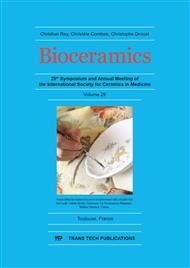[1]
Ginebra MP, Traykova T, Planell JA. Calcium phosphate cements as bone drug delivery systems: A review. Journal of Controlled Release. 113 (2006) 102-10.
DOI: 10.1016/j.jconrel.2006.04.007
Google Scholar
[2]
Habibe AF, Maeda LD, Souza RC, Barboza MJR, Daguano JKMF, Rogero SO, et al. Effect of bioglass additions on the sintering of Y-TZP bioceramics. Materials Science and Engineering: C. 29 (2009) 1959-64.
DOI: 10.1016/j.msec.2009.03.006
Google Scholar
[3]
Chou J, Valenzuela S, Green DW, Kohan L, Milthorpe B, Otsuka M, et al. Antibiotic delivery potential of nano- and micro-porous marine structure-derived beta-tricalcium phosphate spheres for medical applications. Nanomedicine. 9 (2014) 1131-9.
DOI: 10.2217/nnm.13.116
Google Scholar
[4]
Chou J, Ben-Nissan B, Green DW, Valenzuela SM, Kohan L. Targeting and Dissolution Characteristics of Bone Forming and Antibacterial Drugs by Harnessing the Structure of Microspherical Shells from Coral Beach Sand. Advanced Engineering Materials. 13 (2011).
DOI: 10.1002/adem.201000208
Google Scholar
[5]
Langer R. New methods of drug delivery. Science. 249 (1990) 1527-33.
Google Scholar
[6]
Santos A, Sinn Aw M, Bariana M, Kumeria T, Wang Y, Losic D. Drug-releasing implants: current progress, challenges and perspectives. Journal of Materials Chemistry B. 2 (2014) 6157-82.
DOI: 10.1039/c4tb00548a
Google Scholar
[7]
Macha IJ, Cazalbou S, Shimmon R, Ben-Nissan B, Milthorpe B. Development and dissolution studies of bisphosphonate (clodronate)-containing hydroxyapatite–polylactic acid biocomposites for slow drug delivery. Journal of tissue engineering and regenerative medicine. 11 (2017).
DOI: 10.1002/term.2066
Google Scholar
[8]
Macha IJ, Cazalbou S, Ben-Nissan B, Harvey KL, Milthorpe B. Marine structure derived calcium phosphate-polymer biocomposites for local antibiotic delivery. Marine drugs. 13 (2015) 666-80.
DOI: 10.3390/md13010666
Google Scholar
[9]
Siepmann J, Siepmann F. Mathematical modeling of drug delivery. International journal of pharmaceutics. 364 (2008) 328-43.
DOI: 10.1016/j.ijpharm.2008.09.004
Google Scholar
[10]
Rothstein SN, Federspiel WJ, Little SR. A simple model framework for the prediction of controlled release from bulk eroding polymer matrices. Journal of Materials Chemistry. 18 (2008) 1873-80.
DOI: 10.1039/b718277e
Google Scholar
[11]
Rothstein SN, Federspiel WJ, Little SR. A unified mathematical model for the prediction of controlled release from surface and bulk eroding polymer matrices. Biomaterials. 30 (2009) 1657-64.
DOI: 10.1016/j.biomaterials.2008.12.002
Google Scholar
[12]
Stephens D, Li L, Robinson D, Chen S, Chang H, Liu RM, et al. Investigation of the in vitro release of gentamicin from a polyanhydride matrix. Journal of controlled release : official journal of the Controlled Release Society. 63 (2000) 305-17.
DOI: 10.1016/s0168-3659(99)00205-9
Google Scholar
[13]
Fredenberg S, Reslow M, Axelsson A. Measurement of Protein Diffusion Through Poly(d, l-Lactide-Co-Glycolide). Pharmaceutical Development and Technology. 10 (2005) 299-307.
DOI: 10.1081/pdt-200054473
Google Scholar
[14]
Mohammadi G, Barzegar-Jalali M, Valizadeh H, Nazemiyeh H, Barzegar-Jalali A, Siahi Shadbad MR, et al. Reciprocal powered time model for release kinetic analysis of ibuprofen solid dispersions in oleaster powder, microcrystalline cellulose and crospovidone. J Pharm Pharm Sci. 13 (2010).
DOI: 10.18433/j3jg61
Google Scholar
[15]
Liechty WB, Kryscio DR, Slaughter BV, Peppas NA. Polymers for drug delivery systems. Annual review of chemical and biomolecular engineering. 1 (2010) 149-73.
DOI: 10.1146/annurev-chembioeng-073009-100847
Google Scholar
[16]
Costa P, Sousa Lobo JM. Modeling and comparison of dissolution profiles. Eur J Pharm Sci. 13 (2001) 123-33.
Google Scholar
[17]
Ford Versypt AN, Pack DW, Braatz RD. Mathematical modeling of drug delivery from autocatalytically degradable PLGA microspheres-a review. Journal of controlled release : official journal of the Controlled Release Society. 165 (2013) 29-37.
DOI: 10.1016/j.jconrel.2012.10.015
Google Scholar
[18]
Liechty WB, Kryscio DR, Slaughter BV, Peppas NA. Polymers for Drug Delivery Systems. Annual Review of Chemical and Biomolecular Engineering. 1 (2010) 149-73.
DOI: 10.1146/annurev-chembioeng-073009-100847
Google Scholar
[19]
Severino P, Santana MHA, Malmonge SM, Souto EB. Polymers for Drug Delivery Systems Formulations. Polimeros-Ciencia E Tecnologia. 21 (2011) 361-8.
Google Scholar
[20]
Zhu G, Mallery SR, Schwendeman SP. Stabilization of proteins encapsulated in injectable poly (lactide- co-glycolide). Nat Biotech. 18 (2000) 52-7.
DOI: 10.1038/71916
Google Scholar
[21]
Cabezas LI, Gracia I, de Lucas A, Rodríguez JF. Novel Model for the Description of the Controlled Release of 5-Fluorouracil from PLGA and PLA Foamed Scaffolds Impregnated in Supercritical CO2. Industrial & Engineering Chemistry Research. 53 (2014).
DOI: 10.1021/ie404028t
Google Scholar


